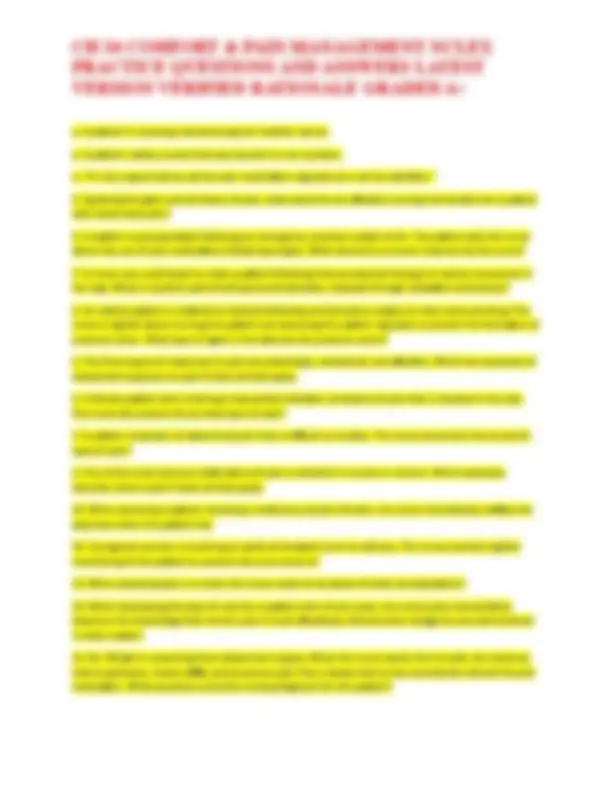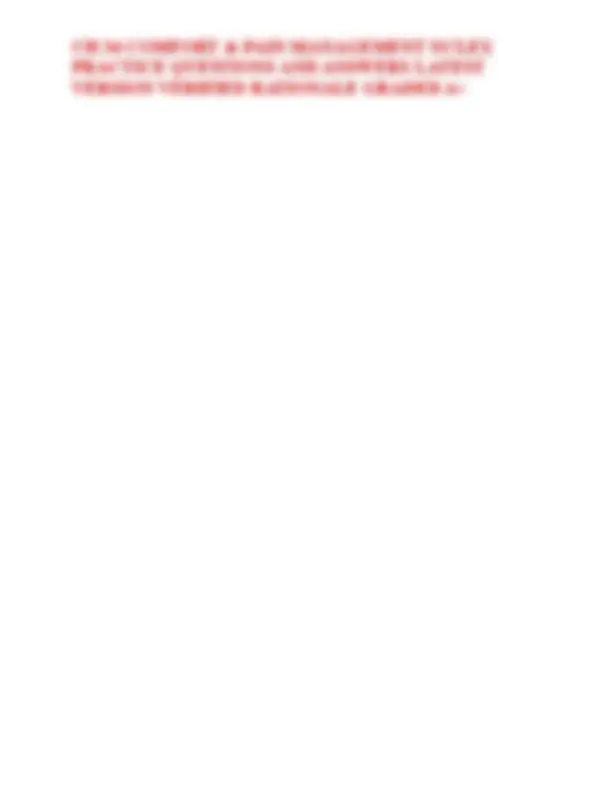






Study with the several resources on Docsity

Earn points by helping other students or get them with a premium plan


Prepare for your exams
Study with the several resources on Docsity

Earn points to download
Earn points by helping other students or get them with a premium plan
Community
Ask the community for help and clear up your study doubts
Discover the best universities in your country according to Docsity users
Free resources
Download our free guides on studying techniques, anxiety management strategies, and thesis advice from Docsity tutors
CH 34 COMFORT & PAIN MANAGEMENT NCLEX PRACTICE QUESTIONS AND ANSWERS LATEST VERSION VERIFIED RATIONALE GRADED A+.pdf
Typology: Exams
1 / 8

This page cannot be seen from the preview
Don't miss anything!





source - ans(Taylor 1191-1192)Taylor, Carol. Fundamentals of Nursing. Wolters Kluwer Health, 10/2014. VitalBook file. f. Pain is classified by duration, location, source, transmission, and etiology. - ansb. Pain exists whenever the person experiencing it says it exists. f. Pain is classified by duration, location, source, transmission, and etiology. f. A patient is experiencing pain from second-degree burns. - ansa. A patient is receiving chemotherapy for bladder cancer. f. A child pulls away from a nurse trying to give him an injection. - ansa. A patient cradles a wrist that was injured in a car accident. f. A child pulls away from a nurse trying to give him an injection. e.. Pain that occurs without a known cause is psychological in nature. e.. Pain that occurs without a known cause is psychological in nature. e. A patient who has chronic cancer pain is depressed and withdrawn. e. A patient has back pain related to an accident that occurred last year. e. A patient has back pain related to an accident that occurred last year. d. Somatic - ansb. Visceral d. Serotonin - ansc. Endorphins d. Risk for Infection related to surgical incision - ansa. Acute Pain related to fear of taking prescribed postoperative medications d. Respiratory depression - ansd. Respiratory depression d. Reported constipation - ansb. A sedation level of 4 d. Referred pain - ansd. Referred pain d. Pain is a simple, universal, and easy-to-describe phenomenon. d. Pain is a simple, universal, and easy-to-describe phenomenon. d. Narcotic analgesic use should be avoided. - ansb. Inadequate or inconsistent relief of pain is widespread. d. Intramuscularly - ansc. Around the clock (ATC) d. FACES scale - ansa. CRIES scale
d. Electrical - ansa. Mechanical d. Ambulating the patient after administering medication - ansb. Applying a moist heating pad to the area at prescribed intervals d. A patient who has fibromyalgia requests pain medication. d. A patient who has fibromyalgia requests pain medication. d. A patient in pain strikes out at a nurse who attempts to bathe him. d. "Your doctor has ordered pain medications for you, which you should not be afraid to request any time you have pain." - ansd. "Your doctor has ordered pain medications for you, which you should not be afraid to request any time you have pain." c. Vomiting c. Superficial c. Reviewing the pain experience with the patient c. Reliable assessment tools are currently unavailable. c. Phantom pain c. Pain is an emotional and sensory reaction to tissue damage. c. Pain is an emotional and sensory reaction to tissue damage. c. Mild confusion c. FLACC scale c. Endorphins c. Chemical c. Around the clock (ATC) c. Anxiety related to outcome of surgery c. A patient's pulse is increased following a myocardial infarction. c. A patient is experiencing a ruptured aneurysm. c. "It's natural to have to put up with pain after surgery and it will lessen in intensity in a few days." b. Visceral b. Urinary retention
a. A patient is receiving chemotherapy for bladder cancer. a. A patient cradles a wrist that was injured in a car accident. a. "It's not a good idea to ask for pain medication regularly as it can be addictive."